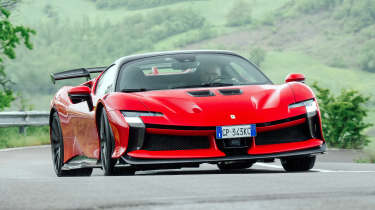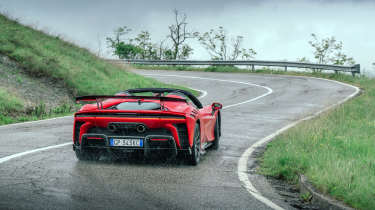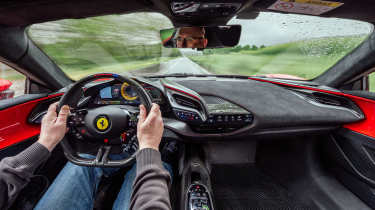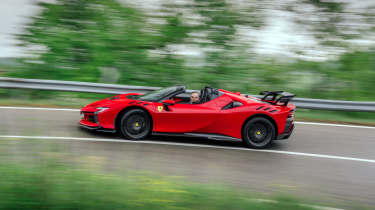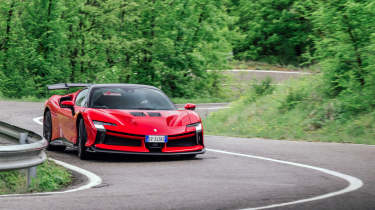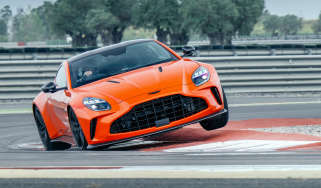Ferrari SF90 XX Spider 2024 review – on the road with Ferrari’s open-top track car
Designed for the track, Ferrari’s latest XX car has been let out on the road
Until now, cars from Ferrari’s XX program cars have been extreme, track-only developments of the firm’s road cars - Enzo, 599 and LaFerrari - created exclusively for ‘client test drivers’ to enjoy at Ferrari-run test days. Although evolved with the same philosophy, the SF90 XX is the first road-legal XX car. The most obvious expression of this track-focused development is the huge, fixed rear wing, literally the central plank of a new aerodynamic strategy that delivers considerably more downforce. The front end has been revised too, improving cooling of the SF90’s hybrid electric hardware and helping liberate an additional 13bhp, while detail work on the 4-litre, twin-turbo V8 adds another 17bhp, lifting the output from 986 to 1016bhp.
We’ve already lapped Fiorano in an SF90 XX coupe and came away deeply impressed with the car’s abilities around the manicured environs of the Ferrari test track. However, with a soupcon of irony, there was no road driving so we were left to speculate how the first XX road car might deal with the cut and thrust of urban traffic and the give and take of a country road. Its steering had a natural feel on track and its chassis had some roll and pitch; it could work well, we thought.
Dropping into the SF90 XX Spider’s driver’s seat the complexity of the switchgear and instruments is bordering on overwhelming; there are two Manettinos: one for the chassis and an ‘eManettino’ for the hybrid powertrain. Double-tap the haptic start/stop button, select ‘Wet’ for the chassis and ‘H’ for hybrid, and we’re moving with a light ‘whoosh’ of electric power.
More reviews
The steering is perfectly weighted and direct but not overly bright and the SF90 XX rides really well, taking the sting out of all manner of road roughness, of which there is plenty on these Italian roads. Thoughts of an edge, angst and pent-up aggression from Ferrari’s most potent road car ever are quietly banished. Instead there’s great visibility, good refinement and an unexpected relaxed demeanour. But remember, this is before the twin-turbo V8 has fired up.
It’s a sparsely trimmed interior with no carpets, fabric-trimmed sills and a lot of naked carbonfibre but it's not as bare as, say the 488 Pista, which sounded hollow, like an empty room. Some plushness is provided by Alcantara trim for the facia, door tops and the seats, which are carbon-framed and some of the lightest Ferrari has ever made (but do offer backrest angle adjustment, thankfully).
A firm prod of the throttle heading uphill wakes the engine. It’s almost comical because it sounds like a lion roaring down a drain pipe, valves-open loud and at a high idle because it’s still cold. And then it’s gone, autonomous hybrid mode reverting to electric again. As the miles build and the electrical well drains, the V8 fires more regularly, becoming smoother and more refined but retaining a more detailed and visceral note compared to the stock SF90. This is thanks to the revised engine sound enhancer, which takes pulses from both the intake and the exhaust manifolds.
Thoroughly warmed through it’s a lovely engine note, smoother-edged and more refined than McLaren’s V8 unit. Oddly, although it shouldn’t come as a surprise, at low speed the car is more positively connected to the throttle when it’s using the electric motors rather than the V8, even though it’s mated to an eight-speed DCT gearbox. Switch up the eManettino to ‘Qualifying’ mode and you get the best of both, with full electrical energy getting the car moving instantly before the V8 picks up and kicks in with full boost. Feeling for the level of grip before summoning up the courage to keep the throttle pinned to the redline takes a while, however, not least because for the full effect you need the regular Manettino dialled to ‘CT off’, so traction control doesn’t restrict the delivery.
Turning the Manettino from Wet to Race takes you from one extreme to another, sharpening the delivery, firming up the damping appreciably and opening the tailpipe valves so that the cockpit fills with the low, resonant growl of the V8 when you’re ambling. A press of the bumpy road button restores a level of suppleness on poor roads and helps traction too.
Snap open the throttle and the car lunges forward instantly, nose lifting, tail squatting, and a fraction later the V8 escalates things wildly, acceleration spiking as its note thins and then hardens again as it hits peak boost and torque. It’s literally head-spinning; the step-off from a rolling start is sudden and slip-free and you never get the chance to recover before full boost hits.
When we first tried the original SF90 at Car of the Year in 2021 it spooked us; its chassis never felt settled, so you couldn’t exploit its extraordinary performance. Subsequent examples are as it should have been from the start, but the SF90 XX feels like another huge step on.
In some ways, building a Spider version of such a track-capable car doesn’t make sense, because it’s heavier in the wrong place, but all 799 XX coupes and 599 Spiders were sold out in a flash, so Ferrari knows its market. Roof up, you could easily mistake the Spider for the coupe, the only difference being the coupe has a sloping rear, continuing the line from the trailing edge of the roof to the glass engine cover. On the Spider this section is stepped, with a flat rear deck that hinges open to swallow up the folded, two-part roof. This means that in the Spider you get a small rear window (which can be lowered) and a view out the back.
The penalty is an increase in weight of 100kg over the coupe, though there’s an aesthetic cost, too, because with the roof stowed you lose the visual tension provided by the coupe’s clean roofline from nose to stern. It’s all a bit too busy. Despite the step, Ferrari says that the aero strategy for both versions remains the same, so too the effect of that huge, fixed rear wing (generating 530kg of downforce at 250kmh).
Helping to balance this is a new front splitter and a revised angle for the front radiator, which cools the electric motors, inverter and batteries, and now vents, a la 296 GT3, through the top of the bonnet, providing a 20 percent increase in front downforce. Trios of vents on the front and rear wings release pressure in the wheel wells and also increase downforce, and there’s lots of discreet aero work going on beneath of course.
The key benefit of the folding roof, which stows in 14 sec, is that it gets you closer to the elements and the sound of the V8 working hard and the audible punctuation of its sportier upshifts is thrilling as it’s delivered with much greater clarity, like you’ve just removed ear plugs.
There’s a further price to pay, though, and it’s a surprising one given that the design of the SF90, particularly the positioning of the window into the engine bay in particular, suggests that it was designed as both Spider and coupe from the outset. That price is that with the roof stowed, the car’s structural stiffness is clearly reduced. You’d think that with its track focused abilities, the Spider might be beefed up a little but even quite modest bumps have the steering jiggling in your hands and the rear view mirror shaking.
This is a shame because the steering and the ride still impress. The overall poise and dynamic cohesion are still encouraging, the steering calm on and around centre but quickening as you apply more lock. In the interests of discovery, I select Qualifying and CT off, and discover it’s possible to make brisk progress with judicious use of the massive performance but the tyres seem to be struggling with the low surface temperatures during our drive.
Push hard into a turn and all is good up to a point, and then the front washes wide. Useful feedback because the rear will probably do the same, and so it proves. Gradually applying a little more throttle through the same corner, the rear eventually breaks, the drop off in grip abrupt, and as with the front, you can feel the tread blocks juddering mildly across the chilly asphalt.
These roads aren’t wide enough or warm enough to see what happens when boost comes in mid-corner, though the way the rear tyres fizz up when the boost hits hard in a straight line offers a pretty good idea. A list of dynamic aids as long as your arm – eSSC 1.0, E4WD, SCM, FDE 2.0, EPS – isn’t going to be much help if you haven’t got any grip. The surface was never fully dry but before returning the car we did get a few opportunities to flatten the throttle and keep it pinned to the redline, and it was epic, particularly that mid-boost phase where the delivery hardens and kicks you in the kidneys.
It’s frustrating that we still don’t have a definitive impression of the SF90 XX’s on road ability. We know that it’s a fantastic track car, scintillatingly fast and surprisingly malleable and engaging, and after this drive we know it has superb steering and surprising dynamic bandwidth. Thanks to its damping range and hybrid powertrain, it can do the commute in EV mode and rip around a track, entertaining as it deploys all 1016bhp. And it feels like it will excel at everything in between, making it a much more usable car that its aggressive looks and XX moniker would suggest. The Spider gets you closer to the action but the Stradale would be our choice, for its greater integrity, fidelity and more cohesive looks.
Price and rivals
It’s a small niche that the SF90 XX Spider operates in, and that’s not only because it costs from £733,000. There are other track-biased hypercars, but few, other Aston Martin’s Valkyrie Spider at £2.365m, are available without a roof. Bugatti will offer an open top version of its Chiron replacement in due course, and GMA will sell you a T.33 Spider for £1.8m, although neither are likely to be as track-focused as the Ferrari despite promising remarkable levels of performance.

